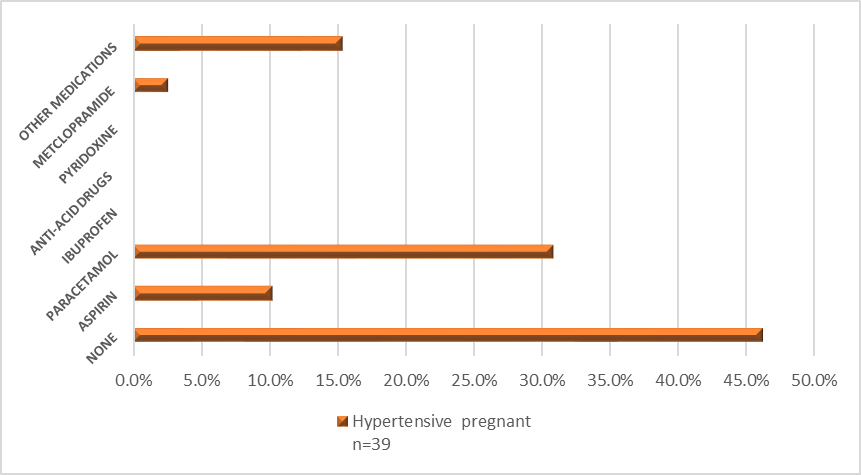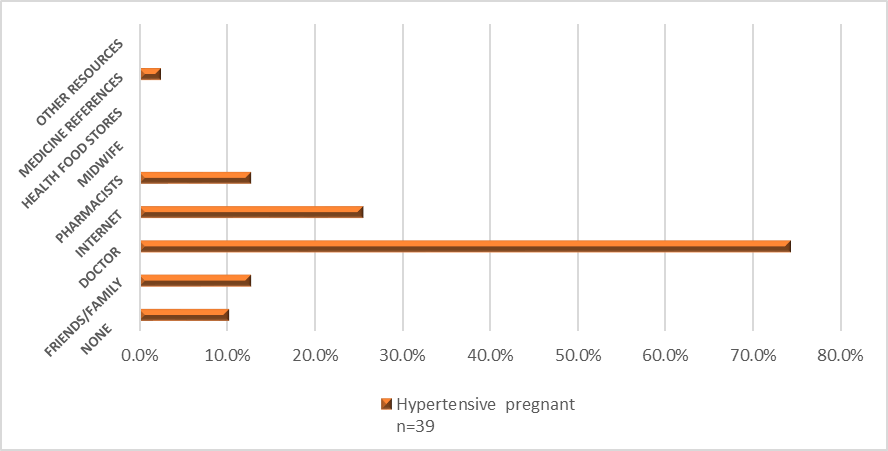Abstract
This study aims to identify the impact of clinical pharmacist’s digital educational program on drug adherence and clinical outcomes among Malaysian hypertensive pregnant women. A quasi-experimental study was undertaken at the antenatal clinic of Hospital Universiti Sains Malaysia (HUSM). The study was carried out with 51 hypertensive pregnant women who were conveniently interviewed. The intervention was an educational program that included 4 video clips and 30 short educational messages. The educational program was started immediately after recruitment through sending the video clips and short messages by WhatsApp application. Descriptive and inferential analyses were performed using SPSS version 22. Total score of drug adherence domain and diastolic blood pressure among hypertensive pregnant women showed significant improvements after the intervention (
Keywords: Pregnant womenWhatsAppHypertensionDigital Education
Introduction
Pharmacists are specialists in medications and can play a main role in the health care system due to their accessibility, experience, and expertise. Patient education and counselling is the main pillar in pharmaceutical care and must be achieved in highly professional and suitable ways.
Patients education is not basically transferring certain information to patients and then asking them to follow up the instructions. However, effective education could be achieved by motivating patients for education by using simple, convenient, and enjoyable educational tools (Jahromi, 2016).
Nowadays, people are lucky since they are living in an era of technology that changed their life in different ways. For an instant, using digital technology in education make it more convenient, attractive and effective. As well, using smartphones in patient’s education is an important addition to education (Short, Lin, Merianos, Burke, & Upperman, 2014) because these phones are widely used among the community and have many grateful features such as simplicity, movability, ability to update, and compatibility to different social applications. WhatsApp is one of the most public social media applications. In Malaysia, using WhatsApp is very common and appropriate among all population ages and classes.
Problem Statement
Pregnant women usually rely on their experience, internet, family or friends as main sources of health information. Thereby, they might use untrusted drug information resources that lead to wrong, incomplete or misleading information that consequently increase the harmful risks on their health and their unborn baby (Finer & Henshaw, 2006; Nordeng, Ystrøm, & Einarson, 2010).
Moreover, the traditional methods of patient’s education might face many obstacles which might influence on the educational process such as working overload, insufficient time, lack of privacy places, and a shortage of health professional staff (Al Laif, Ahmad, Naqvi, & Ahmad, 2017).
On the other side, the studies about drug adherence in pregnant women are scattered and vary among different countries. It was noticeable that more than 50% of pregnant women using medications for chronic diseases were non-adherent (Sawicki et al., 2011). Also, the non-adherence rate in the pregnant population is much higher than the general population (DiMatteo, 2004).
In Malaysia, particularly in Kelantan region (area of study), the rate of hypertension disorders among pregnant women was 3.52% in 2012 (NOR, 2012). Hypertension in pregnancy has many complications on mother. Therefore, hypertension is considered the most common cause of maternal mortality and morbidity (Khan, Wojdyla, Say, Gülmezoglu, & Van Look, 2006; Roberts, Pearson, Cutler, & Lindheimer, 2003). According to National Obstetrics Registry third report 2011-2012, Ministry of Health Malaysia, the average incidence of hypertension in pregnancy-related maternal death was 13.6% from 1997 to 2008.
Research Questions
Would the digital educational program improve hypertensive pregnant women’s drug adherence rate and their clinical outcomes?
Purpose of the Study
To measure the impact of clinical pharmacist’s educational program using digital technology on drug adherence rate and clinical outcome among hypertensive pregnant women in Kelantan, Malaysia.
Research Methods
Study design and site
A quasi-experimental study was conducted at Hospital University Sains Malaysia (HUSM) antenatal clinics. HUSM is a very famous hospital among Malaysian people since it is the best tertiary and teaching hospital on the East coast of Malaysia (Kamari, 2009).
Study population
All pregnant women (age more than 18 years old, have hypertension disease, able to read in the Malay language and used WhatsApp application) who visited the antenatal clinic during the study period (10/2017-10/2018) were voluntarily invited to participate in the study. However, all pregnant women (in critical or labor situation, refused to participate, or did not meet the inclusion criteria) were excluded from the study.
Sample size estimation
Since the number of pregnant women with hypertension at HUSM was small (NOR, 2012), the researchers approached to invite all patients who met the inclusion criteria.
Research tools
Three research tools are used in this study. The first tool was a validated structured Morisky-Green-Levine (MGL) questionnaire (
Data collection method
Three phases are used to collect the data in this study. Phase one was before starting the education, when trained nurses interviewed participants at the waiting area of the antenatal clinic by using the adherence questionnaire. Simultaneously, the researchers reviewed the medical records of pregnant women who agreed to participate in the study to collect their baseline clinical outcomes. Phase two was sending educational materials to pregnant women immediately after recruitment. Providing educational materials were in a structured way where participants received one daily message and one weekly video clip. However, phase three was started at the end of intervention where participants filled up the same questionnaire that they filled before the education. As well, the same clinical data collection sheet was used to follow up the clinical results within two antenatal visits after completing the intervention.
Data analysis
Drug adherence levels were categorized according to MGL adherence tool (
Findings
Only 39 pregnant women, out of 51 patients completed all the study phases. All participants were Malay with age of more than thirty years old. As well, most of them were living in a village, had an unplanned pregnancy and had a secondary education level. Moreover, majority of them were in the last gestational age when they participated in the study and most of them never visit or had only one visit to the dental clinic during pregnancy. However, it was necessary to say that; none of all participants was smoker or alcohol drinker (Table
Nevertheless, while most of the pregnant women reported that they did not use self-medication during pregnancy, paracetamol was the common drug used as over the counter (OTC) drug (30.8%) followed by aspirin (10.3%) (Figure

As well, the primary sources of drug information among most of participants were the physicians followed by the internet, and family/friends whereas only a small percentage of pregnant women (12.8%) who rely on pharmacists as a source of drug information as illustrated in Figure

When the clinical outcomes of pregnant women measured at different periods (baseline, end of the intervention, and follow up), a significant improvement in diastolic blood pressure was noticed (
Similarly, significant improvement was seen among participants with low drug adherence level where their number at this level significantly decreased at the end of the intervention (
Conclusion
Using digital technology in education is an effective method which significantly improved drug adherence rate and diastolic blood pressure among hypertensive pregnant women. The study pointed out the important role of the digital technology in education processes and using it as a tool for delivery the educational material was effective and promising.
References
- Al Laif, F. Z., Ahmad, R., Naqvi, A. A., & Ahmad, N. (2017). Pharmacist perceived barriers to patient counseling; a study in eastern region of Saudi Arabia. Journal of Pharmaceutical Research International, 19(6), 1-12.
- DiMatteo, M. R. (2004). Variations in patients' adherence to medical recommendations: a quantitative review of 50 years of research. Medical care, 42(3), 200-209.
- Eyers, S., Weatherall, M., Jefferies, S., & Beasley, R. (2011). Paracetamol in pregnancy and the risk of wheezing in offspring: a systematic review and meta‐analysis. Clinical & Experimental Allergy, 41(4), 482-489.
- Finer, L. B., & Henshaw, S. K. (2006). Disparities in rates of unintended pregnancy in the United States, 1994 and 2001. Perspectives on sexual and reproductive health, 38(2), 90-96.
- Jahromi, Z. B. (2016). A study of the barriers and facilitators of patient education from the viewpoint of nursing students at Jahrom College of Nursing. Bangladesh Journal of Medical Science, 15(3), 471-476.
- Kamari, Z. (2009). Hospital Universiti Sains Malaysia (HUSM): 25 years of excellent service. The Malaysian journal of medical sciences: MJMS, 16(1), 16.
- Khan, K. S., Wojdyla, D., Say, L., Gülmezoglu, A. M., & Van Look, P. F. (2006). WHO analysis of causes of maternal death: a systematic review. The lancet, 367(9516), 1066-1074.
- Kozer, E., Costei, A. M., Boskovic, R., Nulman, I., Nikfar, S., & Koren, G. (2003). Effects of aspirin consumption during pregnancy on pregnancy outcomes: Meta‐analysis. Birth Defects Research Part B: Developmental and Reproductive Toxicology, 68(1), 70-84.
- Morisky, D. E., Green, L. W., & Levine, D. M. (1986). Concurrent and predictive validity of a self-reported measure of medication adherence. Medical care, 24(1), 67-74.
- NHS (2009). The Pregnancy book. United Kingdom: Author press.
- NOR (2012). The third report of National Obstetrics Registry (Third edition). Retrieved from http://www.acrm.org.my/nor/doc/reports/NOR_REPORT_2012.pdf
- Nordeng, H., Ystrøm, E., & Einarson, A. (2010). Perception of risk regarding the use of medications and other exposures during pregnancy. European journal of clinical pharmacology, 66(2), 207-214.
- Oladejo, M., & Bewley, S. (2013). Prescription drug use and medicine taking behaviour in pregnancy. Obstetrics, Gynaecology & Reproductive Medicine, 23(12), 381-384.
- Poehling, K. A., Szilagyi, P. G., Staat, M. A., Snively, B. M., Payne, D. C., Bridges, C. B., ... & Griffin, M. R. (2011). Impact of maternal immunization on influenza hospitalizations in infants. American journal of obstetrics and gynecology, 204(6), S141-S148.
- Roberts, J. M., Pearson, G., Cutler, J., & Lindheimer, M. (2003). Summary of the NHLBI working group on research on hypertension during pregnancy. Hypertension, 41(3), 437-445.
- Sawicki, E., Stewart, K., Wong, S., Leung, L., Paul, E., & George, J. (2011). Medication use for chronic health conditions by pregnant women attending an Australian maternity hospital. Australian and New Zealand Journal of Obstetrics and Gynaecology, 51(4), 333-338.
- Scialli, A. R. (2006). Teratology Public Affairs Committee position paper: maternal obesity and pregnancy. Birth Defects Research Part A: Clinical and Molecular Teratology, 76(2), 73-77.
- Short, S. S., Lin, A. C., Merianos, D. J., Burke, R. V., & Upperman, J. S. (2014). Smartphones, trainees, and mobile education: implications for graduate medical education. Journal of graduate medical education, 6(2), 199-202.
- WHO (2016). Process of translation and adaptation of instruments. Retrieved from https://www.who.int/substance_abuse/research_tools/translation/en/#
- Zaman, K., Roy, E., Arifeen, S. E., Rahman, M., Raqib, R., Wilson, E., ... & Steinhoff, M. C. (2008). Effectiveness of maternal influenza immunization in mothers and infants. New England Journal of Medicine, 359(15), 1555-1564.
Copyright information

This work is licensed under a Creative Commons Attribution-NonCommercial-NoDerivatives 4.0 International License.
About this article
Publication Date
30 March 2020
Article Doi
eBook ISBN
978-1-80296-080-8
Publisher
European Publisher
Volume
81
Print ISBN (optional)
-
Edition Number
1st Edition
Pages
1-839
Subjects
Business, innovation, sustainability, development studies
Cite this article as:
Al-Shakhshir, S., Azhar, S., Alhaddad, M., & Pazudin, M. (2020). Impact Of Digital Educational Program On Clinical Outcomes Among Hypertensive Pregnant Women. In N. Baba Rahim (Ed.), Multidisciplinary Research as Agent of Change for Industrial Revolution 4.0, vol 81. European Proceedings of Social and Behavioural Sciences (pp. 1-8). European Publisher. https://doi.org/10.15405/epsbs.2020.03.03.1
